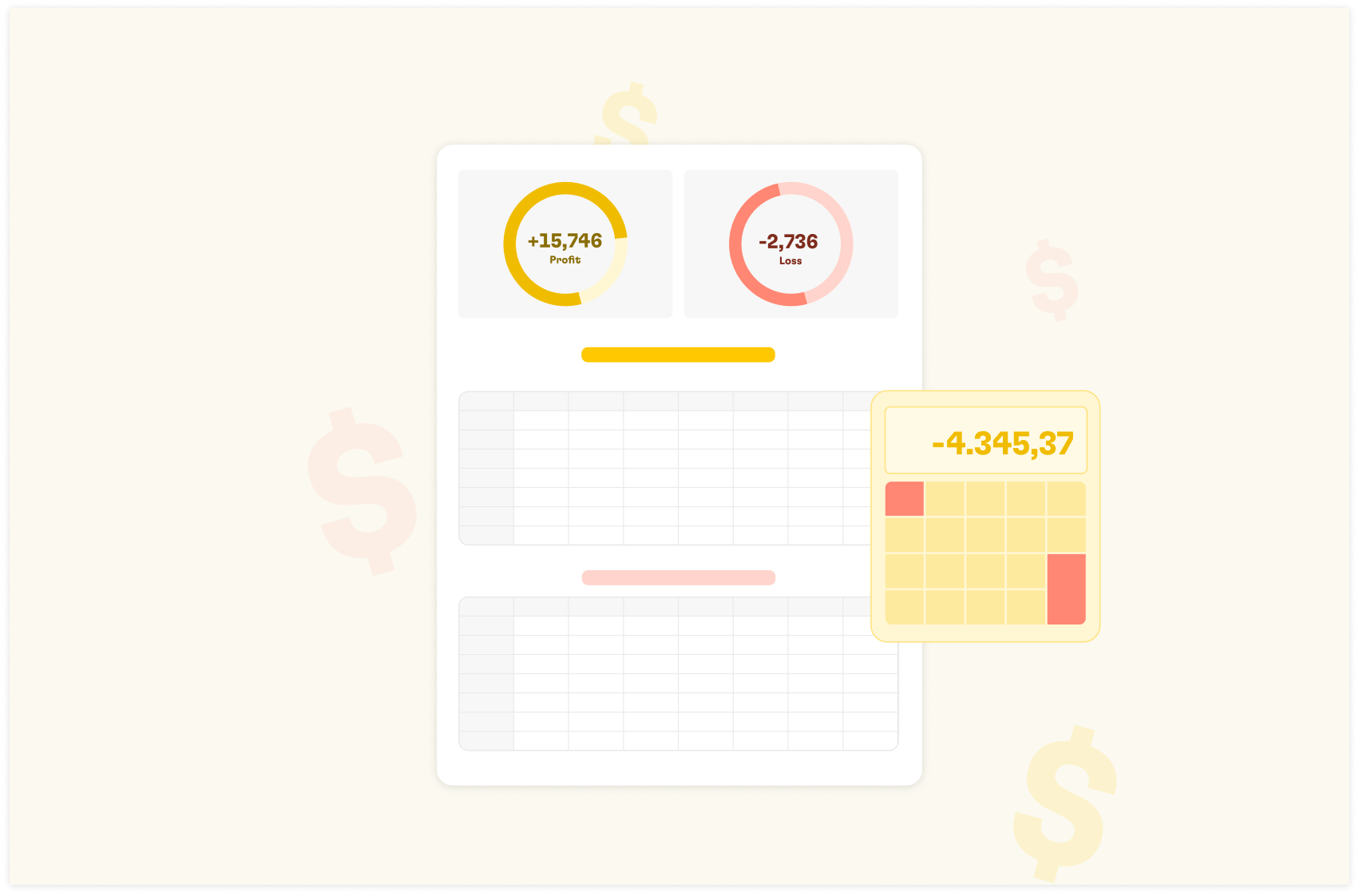15 Best Free Profit and Loss Statement Templates for 2025


Profits and loss templates provide a structured view of your revenue streams and expenses.
They make it easier to track financial performance over time and automatically help you create profit and loss statements (P&L statements) in split seconds or minutes. Now, you don't need to code formulas or create statements from scratch. All you have to do is input data into a pre-built spreadsheet and get work done.
In this guide, I will explore 15 free P&L statement templates perfect for 2025, ensuring you have the right tools to maintain financial clarity and make data-driven decisions.
What is a Profit and Loss Template?
Profit and loss statement template is also called income statement template. Profit and Loss template is a ready-made financial document that lays out the basics of a company's revenues, costs, and expenses over a specific time period. As a starting point for financial reporting, it helps you track business performance and avoid missing any critical financial details.
What makes a good profit and loss statement Template
A good Profit and Loss template covers everything needed to guarantee accurate financial tracking, whether you're monitoring monthly performance or preparing annual reports.
But first things first, a good P&L template should be tailored to a company’s specific industry, whether real estate, financial institutions, SaaS, or another sector, because each has unique characteristics that must be accurately reflected in the income statement.
In general, a good Profit and Loss template will include:
Revenue Section: Total sales revenue, service income, and other revenue streams. This section breaks down all the money coming into the business.
Cost of Goods/Services: Direct, material, and production costs. This shows exactly what it costs to deliver products or services.
Operating Expenses: Staff costs, rent, utilities, marketing expenses, and administrative costs. This section captures all costs of running the business.
Gross and Net Profit: Calculations showing profit at different stages, from gross profit after direct costs to final net profit after all expenses.
Comparison Periods: Current period alongside previous periods and year-to-date figures for tracking performance over time.
Performance Metrics: Key financial ratios, margin calculations, and performance indicators show business health.
Notes Section + miscellaneous: Space for explaining unusual expenses, one-time costs, or significant changes in financial performance.
Customization Options: Flexibility to add or modify categories based on specific business needs and industry requirements.
Visualization: from charts to catchy colors and tidy spreadsheet tables.

Financial spreadsheets, automated.
Rows lets you automate your financial spreadsheets with live data from your bank accounts.
Get Started (free)Review of 15 best profit and loss statement templates
Template #1 – Rows’ SaaS Income Statement

Per Statista, SaaS's expected annual growth rate in the United States between 2025 and 2029 is 19%. More growth means more income in SaaS. This means that SaaS brands need to start taking financial reporting seriously.
Our Saas Income Statement Template has been designed to help founders and finance professionals working in software businesses to track and analyze their financial performance over a specific period. This template provides a structured format for recording revenues, costs, and expenses, ultimately calculating the net profit or loss for the period.
In addition to these basic components, we offer valuable features like automation and an independent AI analyst that can draft out insights and make meaning out of your wise pool of data figures.
So, if you are racking your brain wondering where some money flew to or wondering how you arrived at a net profit figure, our AI analyst analyzes will help you tell you what you need to know. You can only get access by asking relevant questions based on your spreadsheet.
How to Use the P&L Statement Template
Step 1: Click on the "Use template" button

and save the template in your preferred location

Step 2: Input your company's data into the appropriate cells. Start with your revenue figures, then move on to COGS and operating expenses.

Step 3: Review the automatically calculated totals and percentages.
Key Components of the profit and loss statement Template
Revenue Breakdown: This table categorizes and tracks different sources of income, including product sales, service fees, discounts, and other revenue streams.
Cost of Goods Sold (COGS): This spreadsheet section separates and calculates the direct costs of producing your goods or services, such as infrastructure, hosting costs, customer support tools, etc.
Gross Profit Calculation: This calculation automatically computes your gross profit by subtracting COGS from total revenue.
Acquisition Expenses: This itemizes various operating costs related to customer acquisition, such as sales salaries, bonuses, and marketing spending.
Overhead: This section considers fixed costs needed to keep your business alive, such as technology, R&D, software engineers' salaries, and administrative costs.
Net Profit Calculation: This calculation automatically determines your bottom line by subtracting all expenses from total revenue.
Customizable Categories: This section tailors expense and revenue categories to match your business needs.
Monthly and Annual Views: These views toggle between monthly and annual financial perspectives for comprehensive analysis.
Percentage Analysis: This section views the key line item as a percentage of total revenue for quick ratio analysis.
Year-over-Year Comparison: This comparison chart compares current performance against previous periods to track growth and identify areas for improvement.
Rows Bank Account Integration
What's more with Rows you can enable a connection with your bank account, automating transactions data fetch and saving you tedious manual file imports. Rows use Plaid to make this work.
Plaid is the provider we use to manage the connection. Plaid helps companies build fintech solutions by making it easy, safe, and reliable for people to connect their financial data to apps and services.
With Plaid, Rows transforms manual financial tracking into automated, data-driven insights, eliminating tedious manual tasks.
Step 1: Navigate to the Bank Accounts integration page.
Step 2: Click on the Connect button.

Without connecting, you'll be unable to pull data from your live sources.
Step 3: From the pop-up, click Connect again.
For free plan users, you can use this tool for just 30 days—and afterward, you have to upgrade. If you haven't logged in before trying the page, click “connect.”

Step 4: Click Continue from Plaid’s pop-up
Once you click connect, you'll see a pop-up header that reads: “Rows uses Plaid.” This integration fastens connections to your bank account.

Step 5: Search, select & connect to the bank of your choice
Once you've integrated your account, the next step is to choose the institution you bank with.

For example, for the context of this article, I chose “Bank of America,” and click “continue to login” to further with any choice of yours.

CTA: Watch this video to learn how to Categorize and Report Expenses with Rows Bank account integration
Rows Bank Account integration Use cases
Wondering what you could do with this AI finance tool? Here are some dynamic use cases of Rows bank account integration tool:
Cash Flow Reporting & Forecasting
Build dynamic cash flow dashboards that update automatically with real-time transaction data
Example: Create rolling 13-week cash flow forecasts by combining historical bank data with expected receivables and payables.
Monitor daily cash positions across multiple accounts to optimize working capital.
Cash Management
Consolidate balances across multiple bank accounts for comprehensive liquidity oversight.
Example: Set up automated alerts when account balances fall below specified thresholds to prevent overdrafts
Track intraday cash movements to identify peak funding needs and investment opportunities.
Accounts Receivable Management
Automate payment reconciliation by matching incoming transactions against outstanding invoices
Example: Build live reports that update in real-time as payments clear your bank accounts.
Identify payment patterns to optimize collection strategies and improve cash conversion cycle.
What else is in it for you?
We have an AI analyst—not a person, but an AI assistant that helps you make meaning out of data. The AI Analyst can now help you kickstart your data analysis.
With it, you can turn l numbers into visual stories just by asking it questions.
Here's how it works on a generic marketing dataset:

Financial spreadsheets, automated.
Rows lets you automate your financial spreadsheets with live data from your bank accounts.
Get Started (free)Template #2 – Excel simple income statement

This template is perfect for those who prefer Microsoft Excel’s familiar interface. It summarizes the company's revenues and business expenses, providing a bigger picture of financial performance.
This template is divided into sections, which includes: revenue, total revenue, expenses, total expenses, and below-the-line items, all summed to make up net income over a particular time.
➡️ Download this template here.
Template #3 – Annual profit & loss statement template by Wise

This template by Wise is used for reviewing business performance, and if your company runs finances on Wise, this could be your best bet.
In a tabular spreadsheet format, this template shows an overflow view of the yearly comparison between revenue and expenses. Beneath the table are figures showing “income before tax”, “income tax expense,” and lastly, net profit (loss).
➡️ Download this template here.
Template #4 – Multi-Product profit and loss breakdown template

If you have a store, restaurant, or service business, it's important to have a dynamic P&L template that can show an overview of different products. With this template, you can determine your store’s profit or losses over a customized period.
It features a “costs of goods sold” table with total reductions after data aggregation. In addition, it features a table for sales tax, property tax, and B&O tax. It's different from other templates because it includes multi-products.
Template #5: Startup-Friendly profit and loss layout

This template is for startups. Startups need to demonstrate financial discipline and transparency early on. They can start by using templates to track burn rate, cash flow, and plan funding.
This template contains several metrics elements like P&L by year and quarter. It also includes sales plan, Cost of Goods Sold (COGS), stuffing plan, expenses, balance sheet, and net income.
Template #6 – Service-Based Business profit and loss statement Sheet

A service based business P&L statement template tracks revenue streams, from hourly billing to retainer contracts and project-based income. It monitors billable hours, utilization rates, and client-specific revenue patterns. This clarity helps understand which services and clients generate the most income and identify opportunities for revenue growth.
Template #7 – Nonprofit & Donation-Focused profit and loss statement template

A nonprofit profit and loss statement template is essential for organizations reliant on donations, as it distinguishes between fundraising revenue and program costs. This approach increases accountability and fosters donor trust.
It highlights the use and sources of funds based on different events and projects.
Template #8 – Project-based profit and loss statement template

This template helps track historical data, market trends, and seasonality factors to predict future sales performance.
So, if you have sales or marketing projects and want to analyze different finance metrics related to budget, revenue and expenses, use this template.

Financial spreadsheets, automated.
Rows lets you automate your financial spreadsheets with live data from your bank accounts.
Get Started (free)
Template #9 – Retail store profit and loss statement template

A retail P&L template monitors all revenue streams, including in-store sales, online transactions, and special promotions. It breaks down sales by departments, categories, or individual products, helping store managers understand which items drive the most revenue.
This template shows an in-depth P&L statement with an emphasis on performance, profitability, and growth.
Template #10– Real Estate investment profit and loss statement template

This template allows you to streamline the financial tracking of your rental properties. It records all rental income sources, including monthly rent payments, security deposits, parking fees, and additional charges like pet rent or utilities. It monitors lease terms, rent increases, and occupancy rates to provide a clear picture of property performance.
Template #11 – Ecommerce specific profit and loss statement template

This template offers a clear view of financial metrics for e-commerce businesses. It features a dashboard with charts titled Revenue vs Expenses. It also visually depicts the relationship between gross revenue and key expenses.
It monitors revenue by product category, seasonal trends, and promotional performance. Average order value, customer lifetime value, and repeat purchase rates are tracked to understand purchasing patterns.
Template #12 – Manufacturing cost analysis profit and loss statement template

Depending on manufacturing type, the template supports different costing methods (job costing, process costing, or activity-based costing). It helps determine accurate product pricing and profitability analysis by product line. It features costs of materials, labor resources, and goods manufactured based on a particular time.
Template #13 – Self-employed profit and loss statement template

This template is for creators, freelancers, and personal brands. It summarizesa business’s revenues, expenses, gains, and losses over a given time.
So, if you want to gauge your success as a self-employed worker and plan your finances, this template will show you the perfect overview.
Template #14 – QuickBooks profit and loss statement template

QuickBooks provides a profit and loss template that helps businesses track their financial performance by detailing revenue, expenses, and net income over a specified period. It can be easily generated and customized within QuickBooks Online to compare financial performance across different periods14
Template #15 – Chase’s profit and loss statement template

Chase’s profit and loss template helps businesses organize their financial data by categorizing revenue, expenses, and net profit over a specified period. This template typically includes sections for gross income, cost of goods sold, operating expenses, and other income or expenses, allowing businesses to track their financial performance effective

Financial spreadsheets, automated.
Rows lets you automate your financial spreadsheets with live data from your bank accounts.
Get Started (free)Conclusion
Start using either of these P&L statement templates as soon as you have financial data to input. For most businesses, it's beneficial to update and review your P&L statement monthly, with a more in-depth analysis quarterly and annually.
Profit and Loss templates save you from building financial reports from scratch, keep your financial tracking consistent, and cut down on accounting complexities. That said, you can start out with Rows's Income statement template—without paying a penny. Plus, we offer more advanced automation functionality than other templates on the list.

